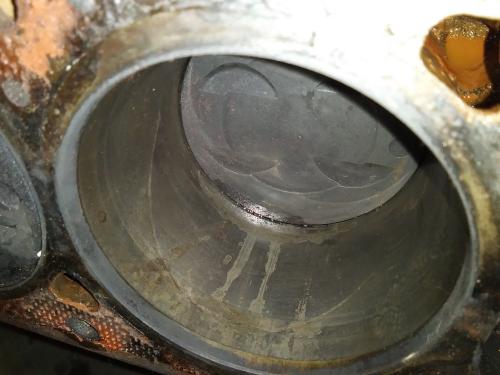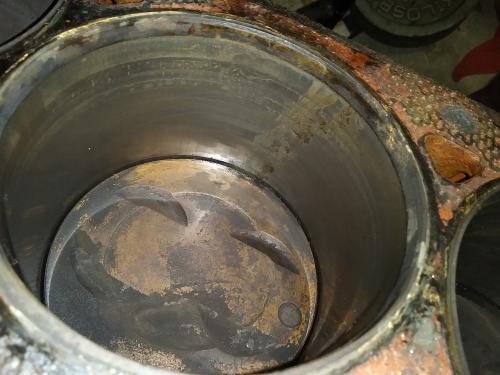1982 F100 Project
|
Administrator
|
Alex, glad to see youre digging in!
I always love to see someone learning about engines. My suggestion, from what I see, is scrape the decks and heads, check for grooves and warp. Rotate the crank while looking in each bore as it reaches BDC with a strong flashlight. Look for scoring, or a spot with any substantial pitting where water sat atop the rings. Look at what you can see of the compression ring to make sure none are broken (but this would likely score the bore) Check the top of each cylinder for a ridge where the rings reach TDC. Can you catch your fingernail on it? Without some expensive bore gauges and the experience to use them you're not going to check for oval or taper. Put some new gaskets on and run it. If it seems to have a bunch of blow by and the bores checked good, run it hard and use some MMO, ATF or Rislone to put pressure on the rings and free them in their grooves. You can always get a bit of coolant in a cylinder from pulling the intake if #5 valve was open. There are coolant crossovers front and back of the intake manifold.
Jim,
Lil'Red is a '87 F250 HD, 4.10's, 1356 4x4, Zf-5, 3G, PMGR, Saginaw PS, desmogged with a Holley 80508 and Performer intake. Too much other stuff to mention. |
|
In reply to this post by Gary Lewis
Thanks for the sage advice Gary. I watched a few videos on using gas or distilled water to check the valves so I plan on doing that. If the valves are leaky or weeping I am going to go ahead and take them in to the machine shop and get them worked on. I will weigh the cost of the machine shop vs buying aftermarket heads at that point but will cross that bridge when we get there.
Unless I find something wrong I am going avoid going further into the engine and depending on the state of the water pump and timing chain, replace those as a 'while its out' kind of thing. I am really looking forward to cleaning everything up posting progress along the way.
1982 F100 3.8L v6
|
|
Administrator
|
If the valves aren't sunk or wobbly in their guides a simple lapping will make them liquid tight.
This is a used engine. It may not be perfect, but it should be quite serviceable.
Jim,
Lil'Red is a '87 F250 HD, 4.10's, 1356 4x4, Zf-5, 3G, PMGR, Saginaw PS, desmogged with a Holley 80508 and Performer intake. Too much other stuff to mention. |
|
In reply to this post by ArdWrknTrk
Thanks Jim!
I did an cursory glance at the cylinder walls and nothing stood out as egregious but I will give it closer look this week. I did run my finder at the top of the cylinder across the ridge but it felt pretty flush with the rest of the cylinder. I could tell it was much rougher but did not feel a difference in diameter. I am probably not explaining that well and will add some pictures to add some color. I am hoping to do exactly what you mentioned, once the cylinder heads are worked out I am going to put new gaskets and run it. I want to avoid going deeper into the engine and see what I have. Thanks -Alex
1982 F100 3.8L v6
|
|
Administrator
|
In reply to this post by ArdWrknTrk
Jim has a really good point. You'll need a spring compressor to remove the springs and check the fit of the valves. But a spring compressor isn't very expensive. So pull a valve at a time and check for wobble. If fairly tight look at the sealing surface of the valve and the head if there are marks consider lapping them.
Your books probably have instructions on how to do that because they are intended for hobbyists.
Gary, AKA "Gary fellow": Profile
Dad's: '81 F150 Ranger XLT 4x4: Down for restomod: Full-roller "stroked 351M" w/Trick Flow heads & intake, EEC-V SEFI/E4OD/3.50 gears w/Kevlar clutches
|
|
Administrator
|
Ok, the Windsor section from the 1985 factory service manual is now on the website. See the Windsor Instructions tab here: Documentation/Engines/Windsor.
Gary, AKA "Gary fellow": Profile
Dad's: '81 F150 Ranger XLT 4x4: Down for restomod: Full-roller "stroked 351M" w/Trick Flow heads & intake, EEC-V SEFI/E4OD/3.50 gears w/Kevlar clutches
|
|
Thanks Gary! Can't wait to use this info.
1982 F100 3.8L v6
|
|
Administrator
|
Actually, I take that back. That's from the 1981 FSM. That's 'cause the '81 has all three Windsor engines and the '85 doesn't.
Gary, AKA "Gary fellow": Profile
Dad's: '81 F150 Ranger XLT 4x4: Down for restomod: Full-roller "stroked 351M" w/Trick Flow heads & intake, EEC-V SEFI/E4OD/3.50 gears w/Kevlar clutches
|
|
Administrator
|
I'd never thought about it, or realized the V-6 was 3/4 of a 302.

Jim,
Lil'Red is a '87 F250 HD, 4.10's, 1356 4x4, Zf-5, 3G, PMGR, Saginaw PS, desmogged with a Holley 80508 and Performer intake. Too much other stuff to mention. |
|
Administrator
|
I'm missing something. The bore and stroke of the V6 is 3.81 x 3.39, and the 302 is 4.00 x 3.00. 
Gary, AKA "Gary fellow": Profile
Dad's: '81 F150 Ranger XLT 4x4: Down for restomod: Full-roller "stroked 351M" w/Trick Flow heads & intake, EEC-V SEFI/E4OD/3.50 gears w/Kevlar clutches
|
|
In reply to this post by ArdWrknTrk
It's not really...at least not in the sense that the 4.3 GM V6 is 3/4 of the 350 V8. The Essex V6 has the small block Ford bellhousing bolt pattern, but I thought that is where the similarities ended. Isn't it referred to as the "small" small block? Although Ford only used that engine very briefly in the early Bullnose trucks, the Essex V6 was later brought back in 1997 as the replacement for the 300 inline 6, and was used for quite a few years after. It was kind of an outlier at the time with it's old school pushrods!
1994 F150 4x2 Flareside. 5.0 w/MAF, 4R70W, stock.
1984 F150 4X2 Flareside. Mild 302 w/ 5spd. Sold. 1980 F150 4X4 Flareside. 300i6 w/ 5spd. Sold in 2021. 1980 F100 4X2 Flareside. 351w/2bbl w/NP435. Sold in 1995 |
|
In reply to this post by ArdWrknTrk
I have been cleaning off the head gaskets and took a look at the cylinders and wanted to get thoughts on some of the wear on the walls.
 Most of the cylinders had similar staining but this one has that scracth you can see as well. It's barely noticeable when I run my fingers nail across it.  Here is another cylinder for reference. Im hoping to get some feedback on if this needs a rebuild or if I can run it from experienced eyes. Thanks all.
1982 F100 3.8L v6
|
|
Administrator
|
I don't think the staining is a problem, but I'm not so sure about the etched places in the second pic. If you can feel the etching then I don't think the rings will seal.
Gary, AKA "Gary fellow": Profile
Dad's: '81 F150 Ranger XLT 4x4: Down for restomod: Full-roller "stroked 351M" w/Trick Flow heads & intake, EEC-V SEFI/E4OD/3.50 gears w/Kevlar clutches
|
|
Thanks Gary. The etch would be at the top of the cylinder? I can feel that upper portion is rougher but I do not feel any edge between the rest of the cylinder wall, which from what I understand would be a sign it needs to be bored out. On Tue, Feb 11, 2020, 8:58 AM Gary Lewis [via Bullnose Enthusiasts] <[hidden email]> wrote: I don't think the staining is a problem, but I'm not so sure about the etched places in the second pic. If you can feel the etching then I don't think the rings will seal.
1982 F100 3.8L v6
|
|
Administrator
|
Sorry, poor terminology on my part. At the top of the cylinder is what is usually referred to as a ridge, and it runs all the way around. It is where the rings haven't run, leaving the original bore size, and below that is the worn cylinder which is larger.
The rule of thumb is that if you can catch your fingernail on the ridge then the cylinder is worn and you'll have to bore it out. But, that is only a guideline. The etch I'm talking about is where the water sat in the cylinder and rusted the wall. That left pits and the rings can't expand down into them so there will be gasses blowing by the rings at that point - called blow-by. That's what I'm concerned about. Let's see what others say about it.
Gary, AKA "Gary fellow": Profile
Dad's: '81 F150 Ranger XLT 4x4: Down for restomod: Full-roller "stroked 351M" w/Trick Flow heads & intake, EEC-V SEFI/E4OD/3.50 gears w/Kevlar clutches
|
| Edit this page |

